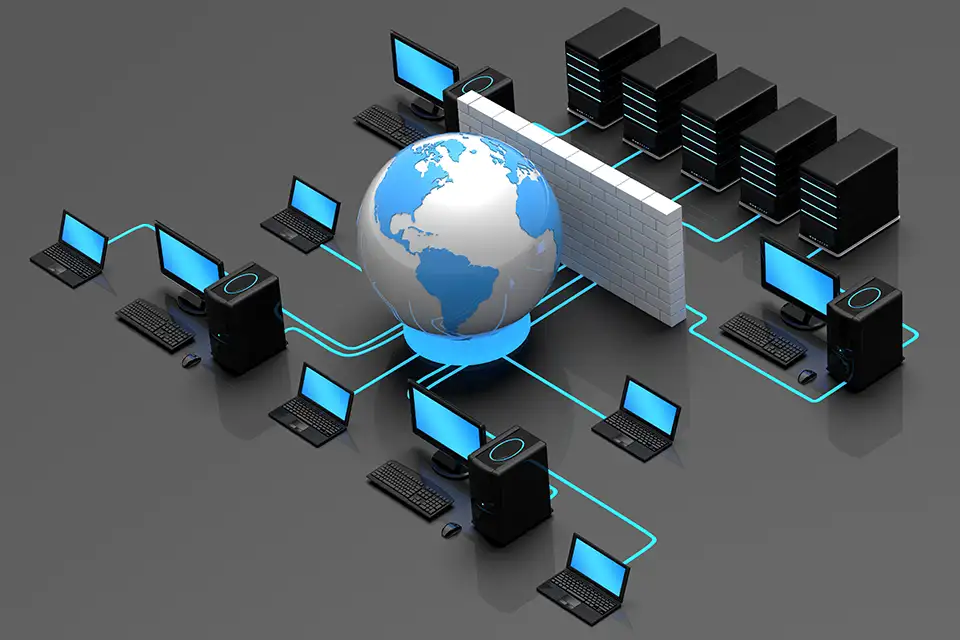Introduction to Firewalls
Acting as protective barriers, firewalls shield private networks from unauthorized access while facilitating safe data exchange. They are not just a passive policing measure but actively monitor, control, and manage incoming and outgoing network traffic based on predetermined security rules. Considering the constant threat of cyber invasions, their significance in cybersecurity cannot be overstated.
Like front-line soldiers in a battle, firewalls form the first layer of defense against potential intrusions. They meticulously filter network traffic, allowing only legitimate data packets. This discerning process prevents malicious actors from breaching sensitive information and halts harmful data before it can infiltrate the network.
The Evolution of Firewall Technology
The narrative of firewall technology is one of relentless adaptation and innovation, mirroring the evolving threats in the digital world. In the bustling world of digital information, types of firewalls stand as vigilant guards, ensuring the safety and integrity of data as it flows across the internet. From the humble beginnings of basic packet filters, today’s firewalls have progressed to sophisticated next-generation firewalls (NGFWs), incorporating advanced features to tackle complex security challenges. The importance of firewall technology is evident in this evolution as it continually rises to meet the demands of relentless cyber threats.
Initially, firewalls served their purpose by examining individual data packets traveling over a network. These packet-filtering firewalls would check protocol, source, and destination addresses to decide whether to allow or block packets. As network attacks became more sophisticated, so did firewalls. They evolved into stateful inspection systems, which assess packets individually and maintain connections’ states, offering enhanced security measures.
Understanding Different Types of Firewalls
- Packet-Filtering Firewalls: Operating at a basic level, these firewalls inspect packets individually and make filtering decisions based on established rules. They are efficient for simple traffic but need help identifying sophisticated threats disguised as trustworthy data.
- Stateful Inspection Firewalls: These firewalls take a more dynamic approach by tracking connection states and applying rules accordingly. They offer added security by understanding context — distinguishing packets involved in genuine activities from those not.
- Application-Level Gateways (Proxy Firewalls): By functioning at the application layer, they offer meticulous control by intercepting and re-routing client requests. This creates a complete firewall disguise, where only the proxy server engages directly with external servers.
- Next-Generation Firewalls (NGFW): The evolving threat landscape demands superior protection, and NGFWs deliver just that with deep packet inspection, intrusion prevention systems, and advanced threat protection technologies — all converged into one formidable defense instrument.
The Role of Firewalls in Cloud Security
Cloud computing has revolutionized how businesses operate, enabling unparalleled flexibility and scalability. However, it has equally challenged traditional security paradigms, necessitating the evolution of firewall technologies. Firewalls in the cloud must address the dynamic nature of virtual environments, securing complex data flow models and protecting sensitive information from unauthorized access. The role of firewalls in this realm has expanded to encompass new security measures tailored to suit cloud platforms’ multitenant and highly elastic nature. Insightful information on cloud security illustrates this intricate transformation, directly correlating enhanced security measures with effective firewall integration.
Modern firewalls, optimized for cloud infrastructures, adapt seamlessly, offering comprehensive protection without compromising efficiency or performance. They counteract risks associated with hyperconnectivity and the decentralized nature of cloud resources, ensuring data integrity, availability, and confidentiality remain uncompromised.
Furthermore, these advanced firewalls leverage real-time threat intelligence to proactively identify and mitigate emerging threats before they can exploit vulnerabilities. Ultimately, their integration into cloud environments fortifies defenses and enhances compliance with regulatory standards, making them indispensable for organizations navigating the complexities of digital security.
Integrating Firewalls with Other Cybersecurity Measures
While formidable in their own right, firewalls achieve optimal effectiveness when integrated into a comprehensive cybersecurity strategy. The modern cybersecurity landscape pivots on a multi-layered approach incorporating firewalls alongside endpoint protection systems, intrusion detection systems (IDS), and consistent security protocols and updates.
This strategy creates an impermeable security net, where various measures fill the gaps others might leave open. For instance, firewalls control traffic flows, endpoint systems secure devices at the user level, and IDS detect infiltrations that firewall rules alone may not catch. Together, these measures synthesize to deliver robust network protection capable of withstanding emerging digital threats.
Real-World Examples of Firewall Success
Consider the real-world success story of a healthcare institution that forestalled a potential breach through diligent firewall management and monitoring practices. By regularly updating firewall configurations and scrutinizing data flows, the institution prevented unauthorized access to sensitive patient information, safeguarding privacy and trust.
In education, a reputed university utilized next-generation firewalls to defend its network against coordinated ransomware attacks. These firewalls detected suspicious activities through advanced threat intelligence, enabling the IT department to neutralize potential threats before they could cause significant disruption or data loss.
Future Trends in Firewall Technologies
Looking ahead, the trajectory of firewall technology promises exciting advancements, particularly with the integration of artificial intelligence (AI) and machine learning (ML). These technologies have the potential to revolutionize firewall capabilities, allowing them to learn and adapt autonomously to new and sophisticated threats.
As AI and ML evolve, they will enable firewalls to predict and respond to threats in real-time more effectively, enhancing overall security posture. This represents a paradigm shift from reactive to proactive defense strategies, where firewalls mitigate existing threats and anticipate and thwart potential attacks before they materialize. These advancements will undoubtedly expand the role of firewalls in safeguarding the digital infrastructure in an increasingly interconnected world.







